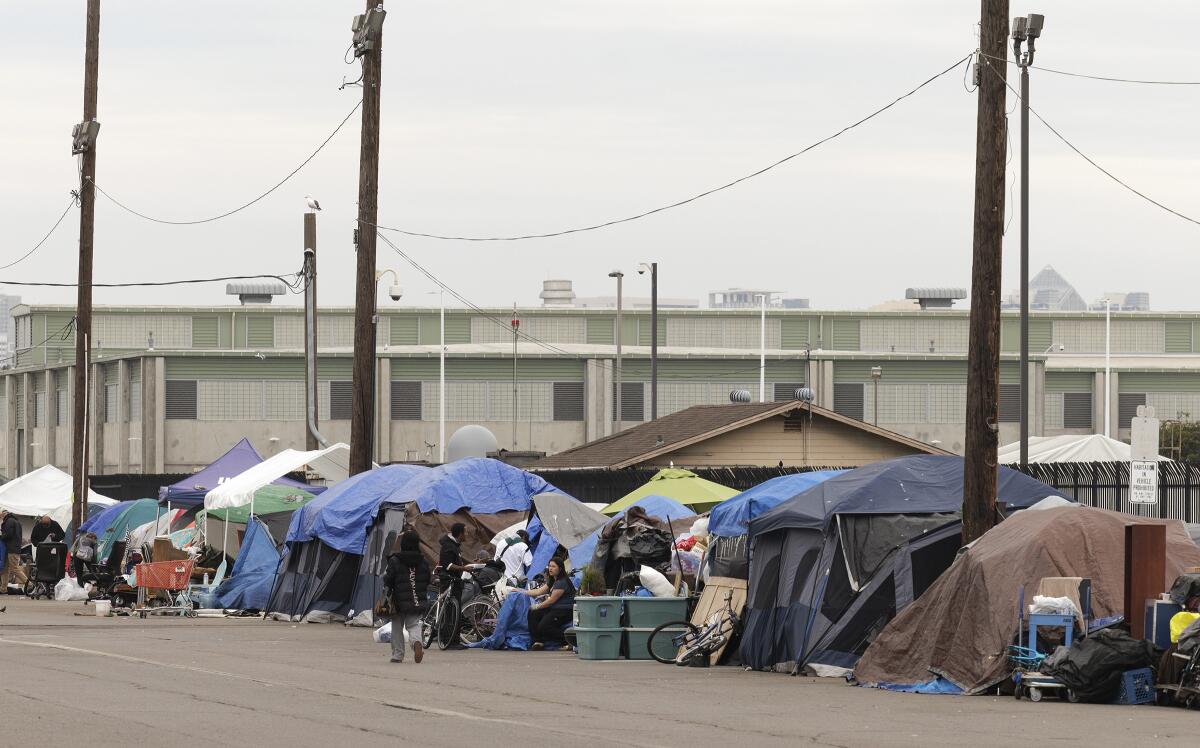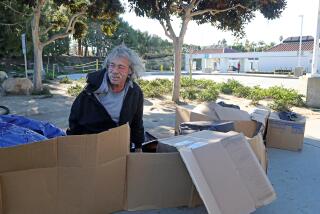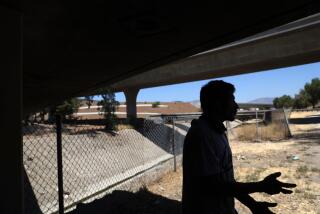San Diego considers banning homeless encampments

Proposal would prohibit camping on some public land 24/7. Camping would still be allowed at night in some areas.
- Share via
SAN DIEGO — A proposal to ban homeless encampments from public property in San Diego will be debated this week by elected officials, and it is expected to be cheered by some as long overdue and jeered by others as cruel and ineffective.
Submitted by City Councilmember Stephen Whitburn, the proposed ordinance would prohibit people from camping on public property if shelter options are available, but it also would ban camping on certain property, such as public parks, even if no legal shelters are available.
The City Council will hold a public hearing on the new rules Tuesday after weeks of protests against the proposed ban countered by a full-court press by Mayor Todd Gloria, who held press conferences at different locations last week in support of the plan.
This story is for subscribers
We offer subscribers exclusive access to our best journalism.
Thank you for your support.
Tuesday’s hearing also follows the release of two reports that show a surge in unsheltered people in the city of San Diego.
“Neither of these announcements come as good news, and neither come as a surprise to myself or to anyone else who has seen what is happening on our sidewalks, in our parks, alongside our freeways and in our canyons along San Diego River,” Gloria said Thursday, the day the reports were released.
Data released Thursday by the San Diego Regional Task Force on Homelessness found a 32% increase in the number of unsheltered homeless people in the city of San Diego, with about 3,300 people living outdoors.
Also on Thursday, a recent count conducted by the Downtown San Diego Partnership found an all-time high of 2,100 people living on sidewalks and in vehicles just in downtown neighborhoods.
While there is little argument that the growing number of encampments in the city is an issue that needs attention, the proposed ban has faced much opposition and did not get overwhelming support when it was discussed by the city’s Land Use and Housing Committee in April.
Committee members voted 3-1 to pass the proposal on to the full City Council without a recommendation. Councilmember Kent Lee cast the only opposing vote and questioned how it could be enforced when the availability of shelter beds was as low as 3% at times.
Lee’s concerns were related to the Martin vs. Boise court decision that allows cities to cite homeless people for camping on property only if there are adequate shelter beds available.
In the meeting, Councilmember Joe LaCava said he had concerns about the proposal and requested a comprehensive shelter plan, which also is going before the City Council on Tuesday.
Gloria said the key elements of the plan include expanding shelter types to fit the specific needs of veterans, seniors, youths and other populations, all with wraparound services to provide what he referred to as compassionate, equitable service to each person.
The plan also calls for engaging with community partners like the San Diego Unified School District and others to identify more potential short-term and long-term shelter sites. It also calls for enhancing the existing family reunification program to connect homeless people with family members and friends who can offer support.
But the plan also identifies future challenges, including the goal of adding 600 more shelter beds while also relocating another 930 beds as some shelters close. Among those are the 276-bed Alpha Project shelter on Newton Avenue, scheduled to close in the summer of 2024, and the 324-bed shelter on the first floor of Golden Hall, which is expected to close by October.
Speaking at various locations in support of the ordinance last week, Gloria said it is needed for safety concerns around schools, parks and canyons.
Opponents have held their own events, which sometimes coincided with Gloria’s. Protesters tried to drown out a press conference on Wednesday held by Gloria, LaCava, police officers and fire officials in University City.
On two consecutive Friday evenings, the grassroots group San Diego Housing Emergency Alliance set up lighted signs reading “Housing Now” on the 6th Avenue Interstate 5 overpass in opposition to the proposal.
Whitburn and Gloria have said the proposed ordinance would not result in encampments disappearing overnight, and it would not affect every neighborhood the same.
In many areas, homeless people still would be allowed on sidewalks between 9 p.m. and 5:30 a.m. as part of a settlement filed several years ago.
In one of the more controversial aspects of the proposed ordinance, camping on certain public property would be prohibited 24 hours a day regardless of the availability of shelter beds. The prohibition would affect public parks and areas near homeless shelters, schools, trolley corridors, transportation hubs and waterways.
That raised another criticism of the proposal, as a homeless person could just cross a street and go to an area where people are allowed to sleep at night.
“It literally is just going to move people into other zones, and if you’re a housed person in a zone not covered by this, you’re going to be unhappy,” said homeless advocate Michael McConnell.
While the restriction may push encampments out of East Village because of shelters in the neighborhood, McConnell said people may just move their tents a few blocks away to Barrio Logan and Sherman Heights.
McConnell also he would pass out maps to show homeless people where they should move their tents if the ordinance passes.
Concern that the ordinance could push homeless people out of San Diego was hinted at during a Poway City Council on Tuesday when council members passed a similar ordinance regulating encampments.
“The city of San Diego is becoming more aggressive, so we’d expect it to be an increasing problem in Poway,” said Poway City Councilmember Brian Pepin.
Whitburn said he expects the ordinance will be effective in part because more shelter options are being created. By July 1, a new safe sleeping area is scheduled to open in a parking lot at 20th and B streets to accommodate about 100 people. The open site will be an alternative to indoor shelters, which many people living on the street often decline.
A second safe sleeping site that will accommodate about 400 people is expected to open in the fall at Parking Lot O near the Naval Medical Center.
Whitburn, whose district includes downtown San Diego, said there is a pressing need to address the hundreds of encampments that are blocking city sidewalks, which could create a liability for the city.
Whitburn noted that Portland, Ore., recently agreed to spend millions of dollars to clear tents from sidewalks to settle a lawsuit filed by disabled people who use wheelchairs.
“I think what happened in Portland is very relevant to the situation we have in San Diego,” he said.
Gloria said the city also has an obligation to residents who deserve to have clean sidewalks.
“Taxpayers in this city will be spending over $200 million on homelessness in the year ahead if the budget is passed as proposed,” he said. “I think in exchange for that, it is absolutely reasonable to be able to expect to walk on the sidewalk without having to go around and step in the middle of the street.”
Questions about the legality of the proposed ordinance already are being raised.
Attorney Scott Dreher, who has represented homeless people in lawsuits that led to the settlement allowing people to sleep on sidewalks at night, said he is looking into the ordinance.
The proposed ordinance also has gotten the attention of Will Knight, decriminalization program director for the Washington, D.C.-based National Homelessness Law Center.
Knight said the proposed ordinance appears to follow the Martin vs. Boise agreement on the surface by enforcing a camping ban only when there are adequate shelter alternatives available.
The part of the ordinance that would prohibit camping in certain areas even when no shelter beds are available is problematic, he said.
“There aren’t exceptions,” he said. “Martin v. Boise does not say they can do what they’re trying to do.”
Knight said a reasonable interpretation of the ruling would find it acceptable to have an absolute ban on camping in certain areas because of legitimate public safety concerns. As examples, he cited cities that banned camping under a railroad viaduct and in wildlife areas. He also had no problem with Santee’s ban on camping near a river that could be polluted by runoff from encampments.
Knight said San Diego is not citing legitimate public safety concerns in banning camping near schools, parks and other places, but rather is just trying to hide homeless people from the sight of children and people in parks.
Whitburn and Gloria said the city attorney’s office has looked at the Martin vs. Boise decision and has found the ordinance in compliance.
“They are confident that in cases of public health and safety, this will be allowable,” Whitburn said.
Gloria also said the ordinance will follow the ruling because the city has the right to place restrictions on the use of specific areas.
McConnell said he does not think the ordinance would be effective in the long run because he already has seen the city crack down on encampments, only to eventually back off and have the encampments return.
“I’ve seen it all before,” he said, recalling how a large encampment that once was on Sports Arena Boulevard had been reduced to just a few tents but lately has grown to about 30.
McConnell also said he sees the mayor’s focus on enforcement as a change of heart in someone who had said he would take a more compassionate approach to homelessness than the past administration.
Gloria, however, repeatedly has emphasized that his approach is compassionate because it will lead to people getting shelter and services rather than allowing them to stay on the street where they face threats of violence, vehicle accidents, sex trafficking and drug dealers.
More to Read
Sign up for Essential California
The most important California stories and recommendations in your inbox every morning.
You may occasionally receive promotional content from the Los Angeles Times.











